Original Title: Tokenomist Annual Report 2024
Compiled by: Nancy, PANews
At the end of January this year, Tokenomist released the Tokenomist Annual Report 2024, covering key trends such as token unlocks, low circulation high FDV tokens, Memecoins, and AI agents, revealing their impact on market liquidity, investor sentiment, and long-term value capture.
The report notes that 2024 began with the issuance of several significant projects characterized by low circulation and high FDV (Fully Diluted Value), setting the tone for the industry's development trajectory. However, market sentiment shifted mid-year. The divergence in investor preferences was reflected in the transition from short-term, low market cap tokens with lock-up vesting plans to fully unlocked, community-driven Memecoins. By the end of the year, the "Super MEME Cycle" became the dominant narrative, attracting widespread attention.
Key Points:
It is expected that over $150 billion in tokens will be unlocked from 2024 to 2025, with approximately $82 billion absorbed in 2024 alone.
By the end of 2024, the average circulation/FDV ratio at the time of token issuance rose to 35%.
The MEME sector in 2024 saw returns as high as 536%, far exceeding the performance of Bitcoin and Ethereum.
The long-term success rate of Memecoins is very low, with 97% ultimately "dying," and an average lifespan of about 1 year, with many tokens disappearing in a shorter time frame.
Autonomous entities combining MEME, AI, and social media have emerged as a new trend in crypto, with frameworks like Virtuals and ai16z leading the innovation.
Top Five Unlock Events of 2024
Token unlock events are key milestones in the crypto market. The release of locked tokens into circulation according to scheduled vesting plans can impact prices and funding rates, especially in the short term. Therefore, this section analyzes the five largest unlock events of 2024, focusing on price impacts and funding rate trends within a 60-day window (-30 to +30 days). By analyzing the relationship between funding rates and price changes, we can assess whether market expectations (as reflected in derivative positions) align with actual price trends. This provides valuable insights into market sentiment, particularly during critical events like token unlocks.
1. Arbitrum (ARB): Unlock Value of $2.22 Billion
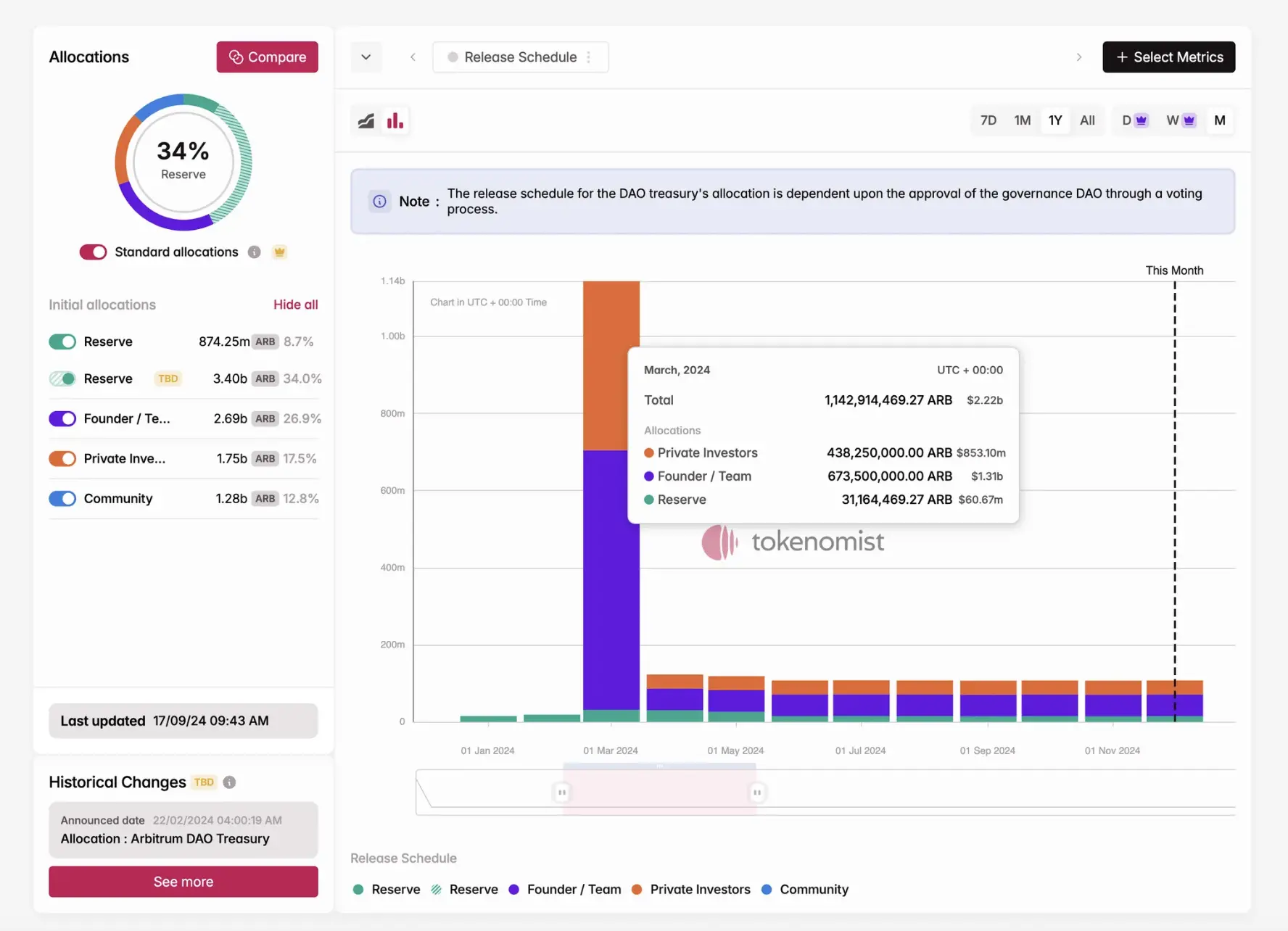
In March 2024, when Bitcoin reached a new historical high of $74,000, Arbitrum (ARB) initiated the largest token unlock event of the month, with a value of $2.22 billion. This marked the first unlock for Arbitrum's private investors and founders/team, introducing a significant amount of new token supply to the market.
In terms of price impact, ARB's price steadily declined before the unlock date, possibly reflecting cautious trading behavior in anticipation of increased supply. Within 30 days post-unlock, ARB's price impact continued to decline by 33.8%, likely related to the influx of more supply.
Regarding funding rates, ARB's funding rate closely mirrored BTC's funding rate over the 60 days but remained consistently higher than BTC, reflecting a higher demand for leveraged positions during that period.
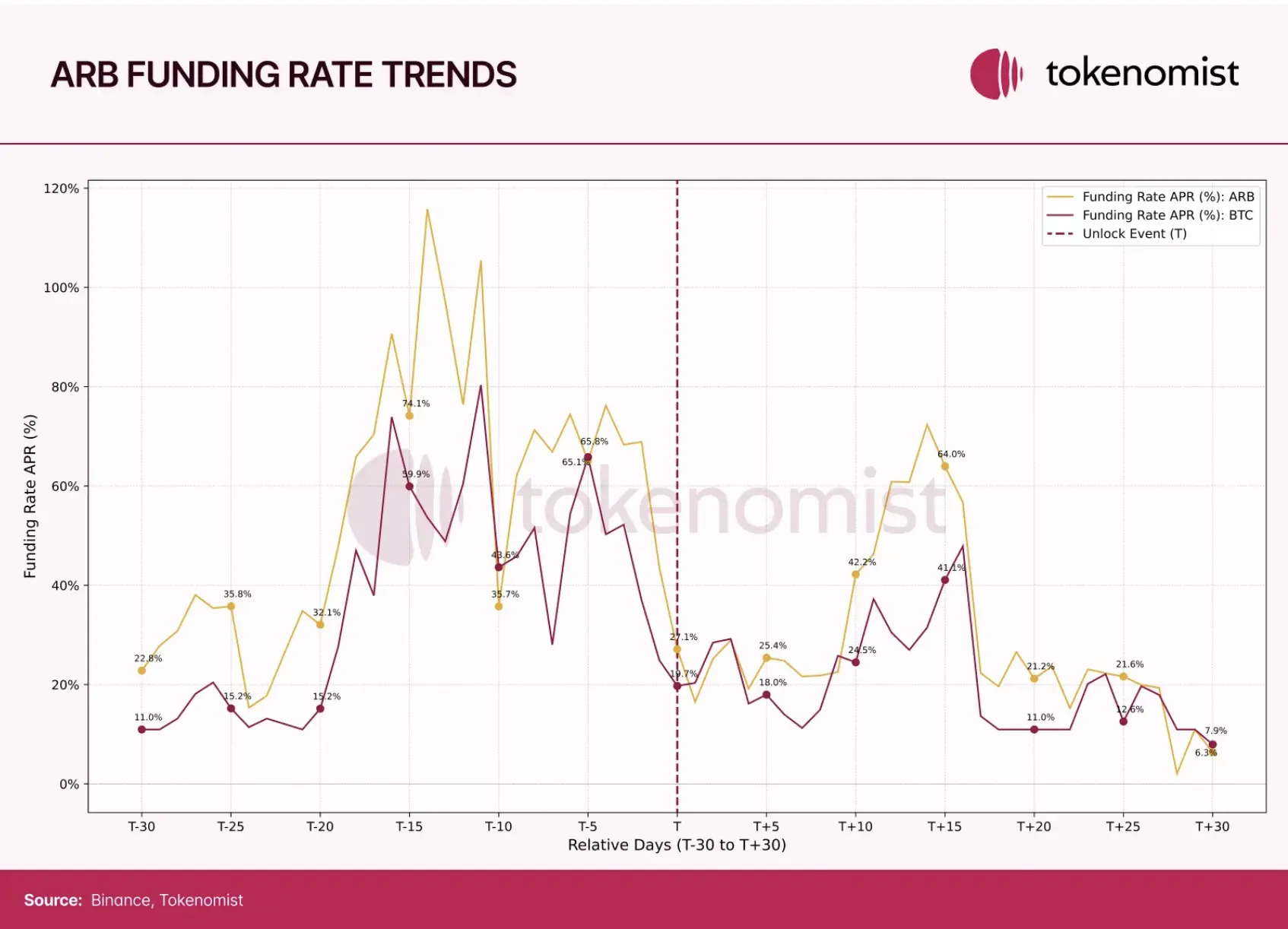
2. Sui (SUI): Unlock Value of $1.21 Billion

In May 2024, Sui (SUI) was the second-largest unlock event of the year, with a value of $1.21 billion. This unlock released a substantial amount of token supply, with most allocated to private investors.
Analyzing the price impact, SUI's price increased by 39.6% in the 30 days leading up to the unlock, but fell by 20.3% in the 30 days following the unlock.
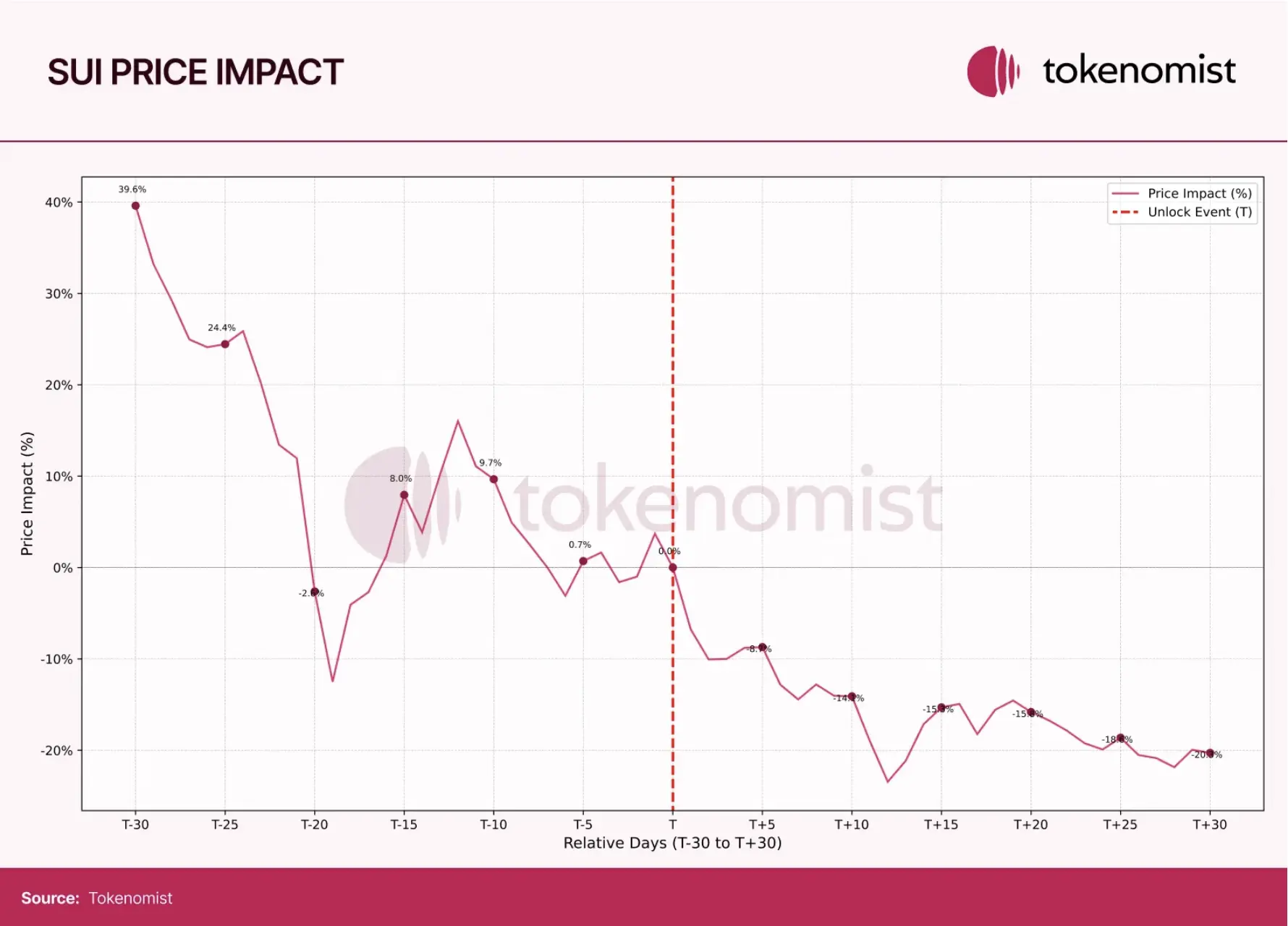
In terms of funding rates, SUI's funding rate entered negative territory 20 days before the unlock, reaching -34.1% on the day of the unlock, indicating pessimism leading up to the event. Approximately 20 days post-unlock, SUI's funding rate rebounded and aligned with BTC's funding rate (around 11.0%).
3. Celestia (TIA): Unlock Value of $977.44 Million

In October 2024, Celestia (TIA) initiated a significant unlock event valued at $977.44 million. This was TIA's first major unlock since the TGE event, becoming one of the largest token unlocks of the year, with the vast majority allocated to private investors and founders/team. The unlock for private investors and founders/team dominated, ensuring continued incentives for long-term contributors and early supporters.
Regarding price impact, TIA's price consistently declined before the unlock, dropping by 25% in the 20 days following the unlock. However, it quickly rebounded, exceeding BTC by 19.2% within 30 days post-unlock.
TIA's funding rate chart was more volatile than other tokens. On the day of the unlock, TIA's funding rate remained in negative territory (-61.1%), but recovered to positive values within a few days, quickly aligning with BTC's funding rate.
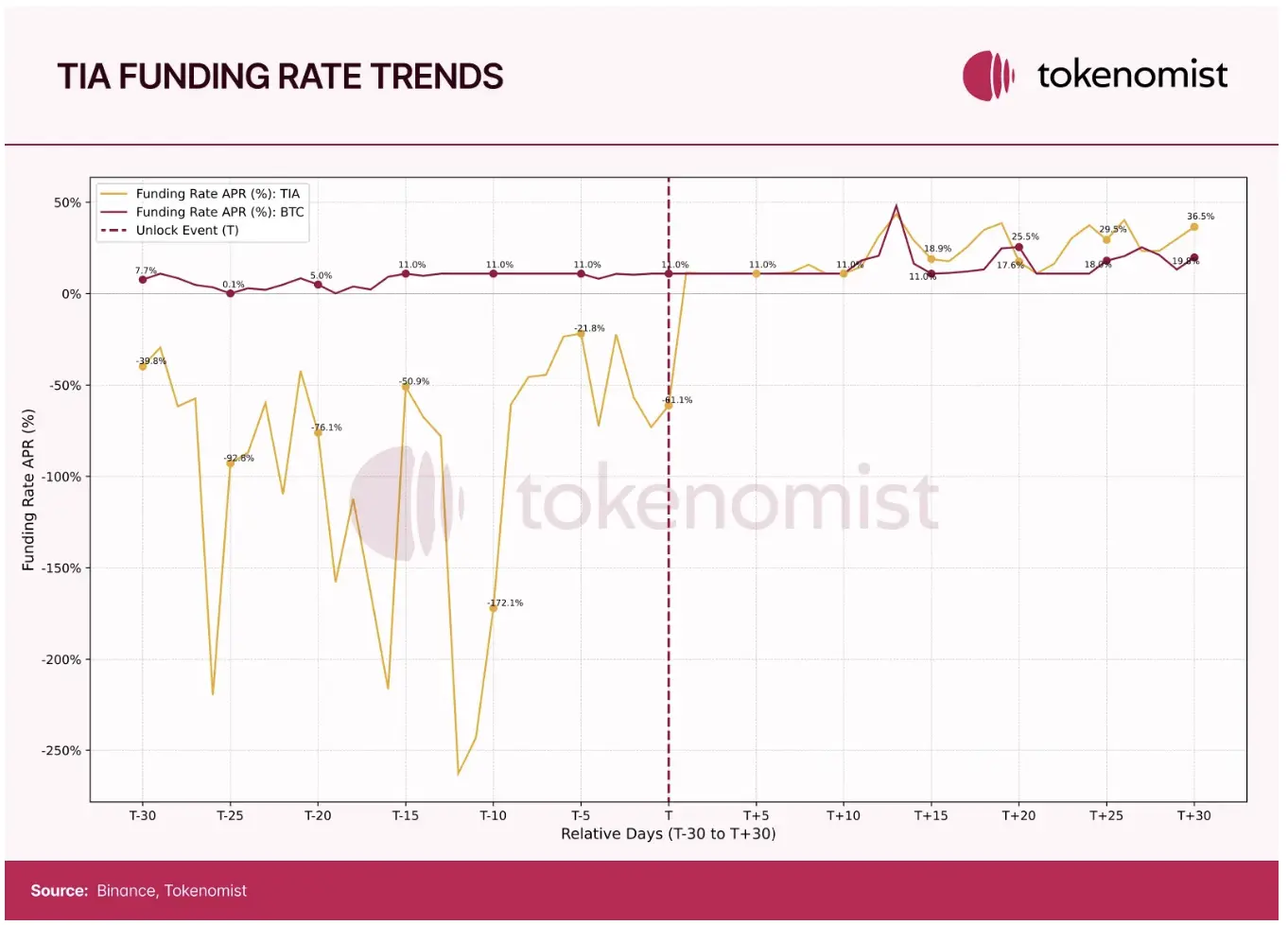
4. Jito (JTO): Unlock Value of $563.91 Million
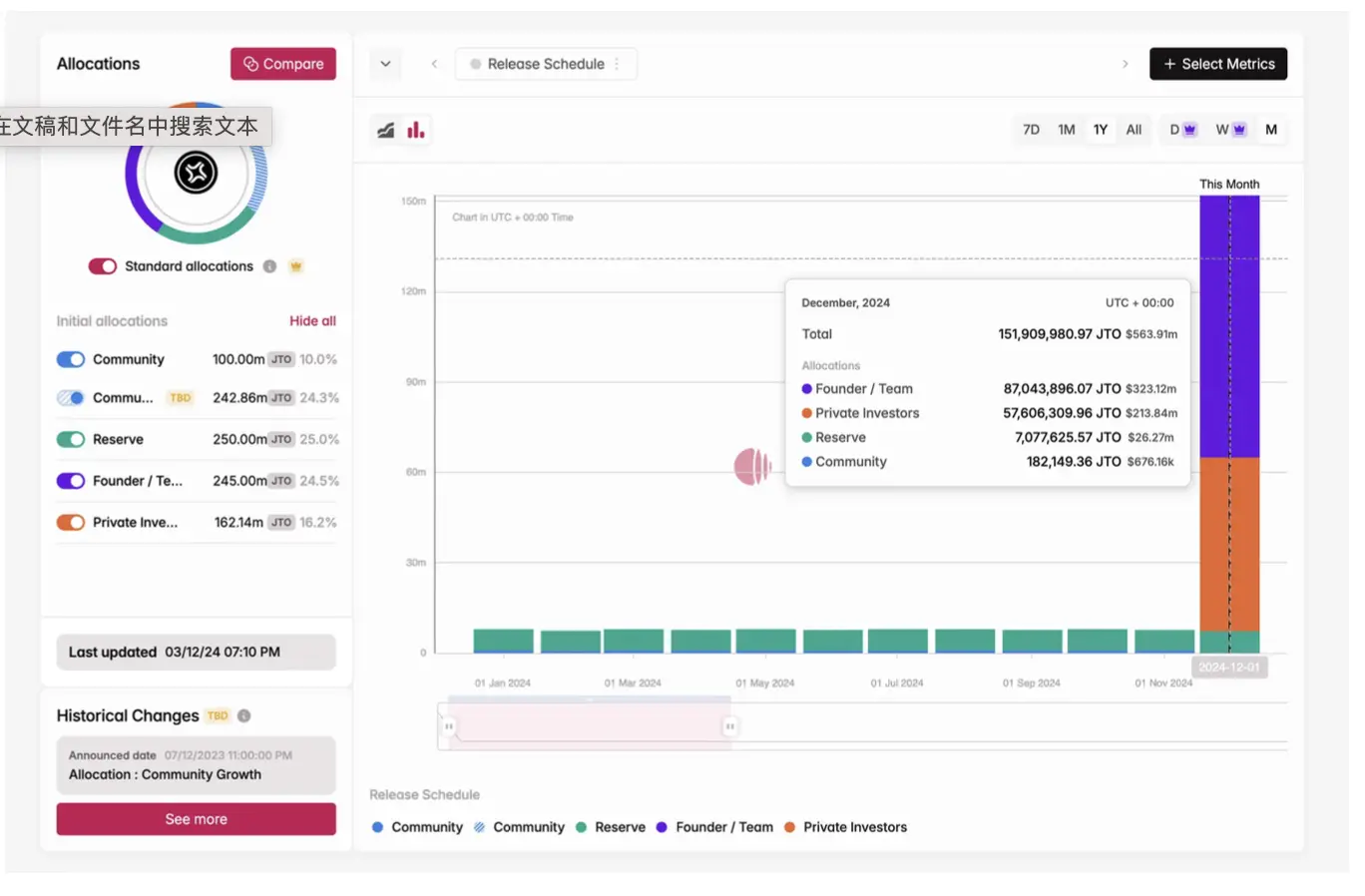
In December 2024, JTO concluded the year with a significant unlock event valued at $563.91 million, releasing 151,909,981 JTO into circulation. The founding team led the unlock, accounting for 57.3%, followed by private investors at 37.9%. This was not surprising.
Due to significant market volatility at the time, when observing price impact, we saw JTO's price impact shift from negative to positive twice before the unlock. Post-unlock, the price impact continued to rise, then sharply declined to about -15%. By the end of the 30 days, it shifted back from positive to negative.
The funding rate trend also reflected this volatility. In the 30 days leading up to the unlock, JTO's funding rate roughly matched BTC, sometimes exceeding it and sometimes falling below it. However, in the 30 days following the unlock, we observed continuous fluctuations in JTO's funding rate, while BTC remained relatively calm.

5. Aptos (APT): Unlock Value of $423.6 Million
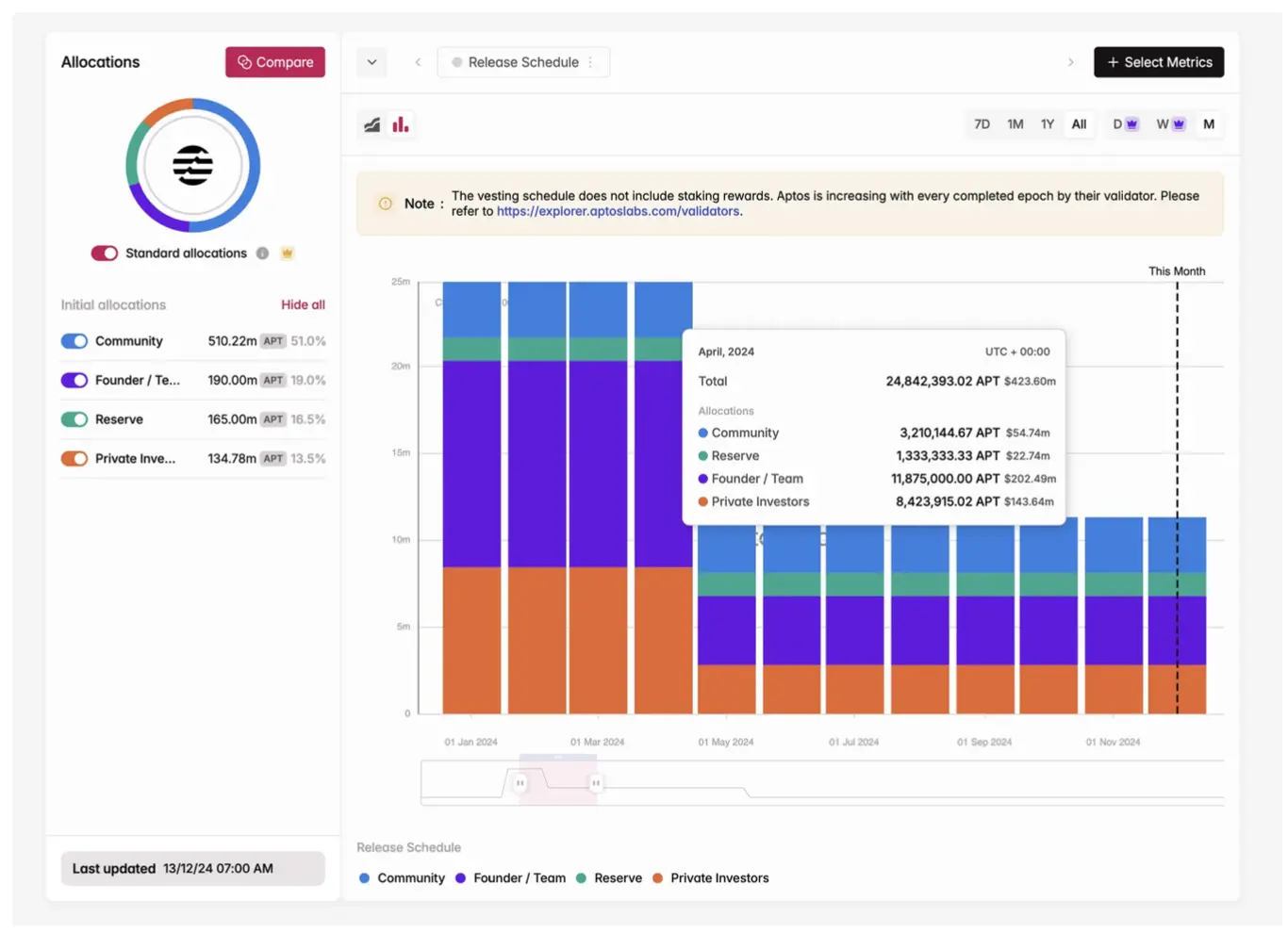
The fifth-largest unlock event of the year occurred in April 2024, when Aptos (APT) conducted an unlock valued at $423.6 million. The founding team and private investors held the largest share of the unlock, with approximately 13% allocated to the community.
APT's price impact surged by about 51.7% in the 5 days leading up to the unlock (from 20 days to 15 days before the unlock), driven by heightened trading activity and speculation. However, starting from 15 days before the unlock, the price impact began to steadily decline. In the post-unlock period, the price impact turned negative and remained so for the next 30 days. During this time, the entire crypto market also exhibited a downward trend.
APT's funding rate trend closely mirrored BTC's, similar to ARB's funding rate trend. This suggests that the price impact may have been more influenced by macro factors affecting the entire market.
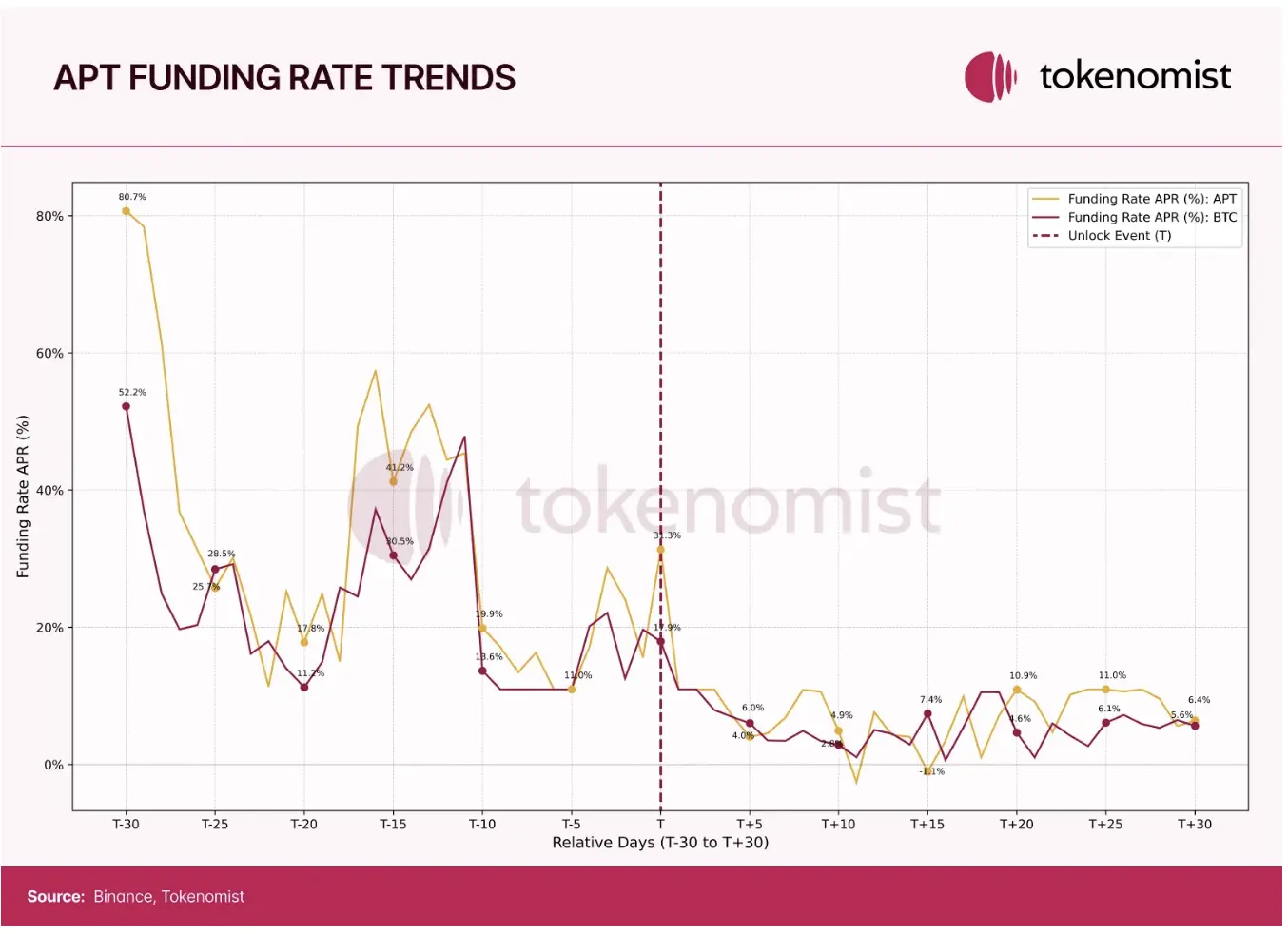
Analysis
By analyzing these token unlock events, it is evident that market sentiment before and after unlocks varies due to factors such as the scale of the unlock, market expectations, macroeconomic conditions, and other influences. Predicting outcomes based on these factors is inherently complex, but they can provide observations that help us understand how key drivers influence market behavior during unlock events.
As these unlock events approach, analyzing market expectations is crucial, which can be observed through price impacts and funding rates. A price drop before the unlock may reflect market concerns about increased supply, while a price increase may indicate market optimism or speculative behavior. Before the SUI unlock in May 2024 and the TIA unlock in October 2024, we observed that both their price impacts and funding rates displayed quite pessimistic sentiment. This aligns with the view that unlock events are generally bearish, as they dilute supply and increase selling pressure. However, there are also instances where the opposite occurs; an unlock can serve as a bullish signal, releasing more supply into the market for buyers to scoop up. We see this in the case of ARB, where the funding rate before the unlock reached +115.8%, indicating increased leverage demand from long positions and optimistic market sentiment.
While these factors provide valuable insights, we must also consider the overall market conditions. During market downturns, larger factors may dominate the price movements of a particular token, as seen in the cases of JITO and APT. The funding rates of these two tokens were closely related to BTC's fluctuations, or exhibited significant volatility when BTC's funding rate remained relatively stable.
Low Circulation High FDV Tokens
Circulation is defined as the ratio of circulating supply to maximum supply, and it has become an increasingly important metric when considering supply data. Low circulation high FDV (Fully Diluted Valuation) tokens, characterized by low circulating supply at issuance but high overall valuation, have become increasingly prominent in recent years. This pattern allows for rapid price appreciation due to limited liquidity, but it has faced criticism for long-term sustainability due to subsequent token unlocks often exerting downward pressure on the market. This section aims to examine the historical context, trends, and impacts of this token economic model, providing a data-driven perspective to assess its viability.
Despite the recent surge in popularity of low circulation high FDV tokens, this pattern is not new. It first gained significant attention during the bull market of 2020-2021. A notable example is Curve (CRV), which was issued in August 2020, with prominent crypto investor Jason Choi highlighting the risks of this pattern using CRV. Within seven hours of trading, CRV's market cap increased from $2 million to $6 million. However, the FDV of the token at issuance was nearly half that of Bitcoin's market cap, proving that such valuations are unsustainable. Early investors faced significant losses, with the price dropping 50% shortly after issuance due to inflation and early sellers exiting their positions, leading to dilution.
The case of CRV reveals a key issue: the initial price movements of low circulation high FDV tokens may mislead investors who overlook the long-term effects of future dilution. Although CRV had its exaggerated inflation mechanism, it laid the groundwork for broader trends that followed.

Analysis of token issuances from 2020 to 2024 shows a clear pattern in the adoption of the low circulation high FDV model. These tokens were particularly prevalent at the end of 2020 and the beginning of 2024, coinciding with Bitcoin's halving and the subsequent bull market.
Over time, the crypto community has become increasingly aware of the risks associated with this model, prompting recent projects to make adaptive adjustments in token economics. A notable trend is the change in the circulation/FDV ratio at issuance. By the end of 2024, the average ratio had risen to about 35%, reflecting greater caution among investors. For example, Binance introduced listing standards that consider TGE (Token Generation Event) circulation, encouraging projects to prioritize sustainable token economics.
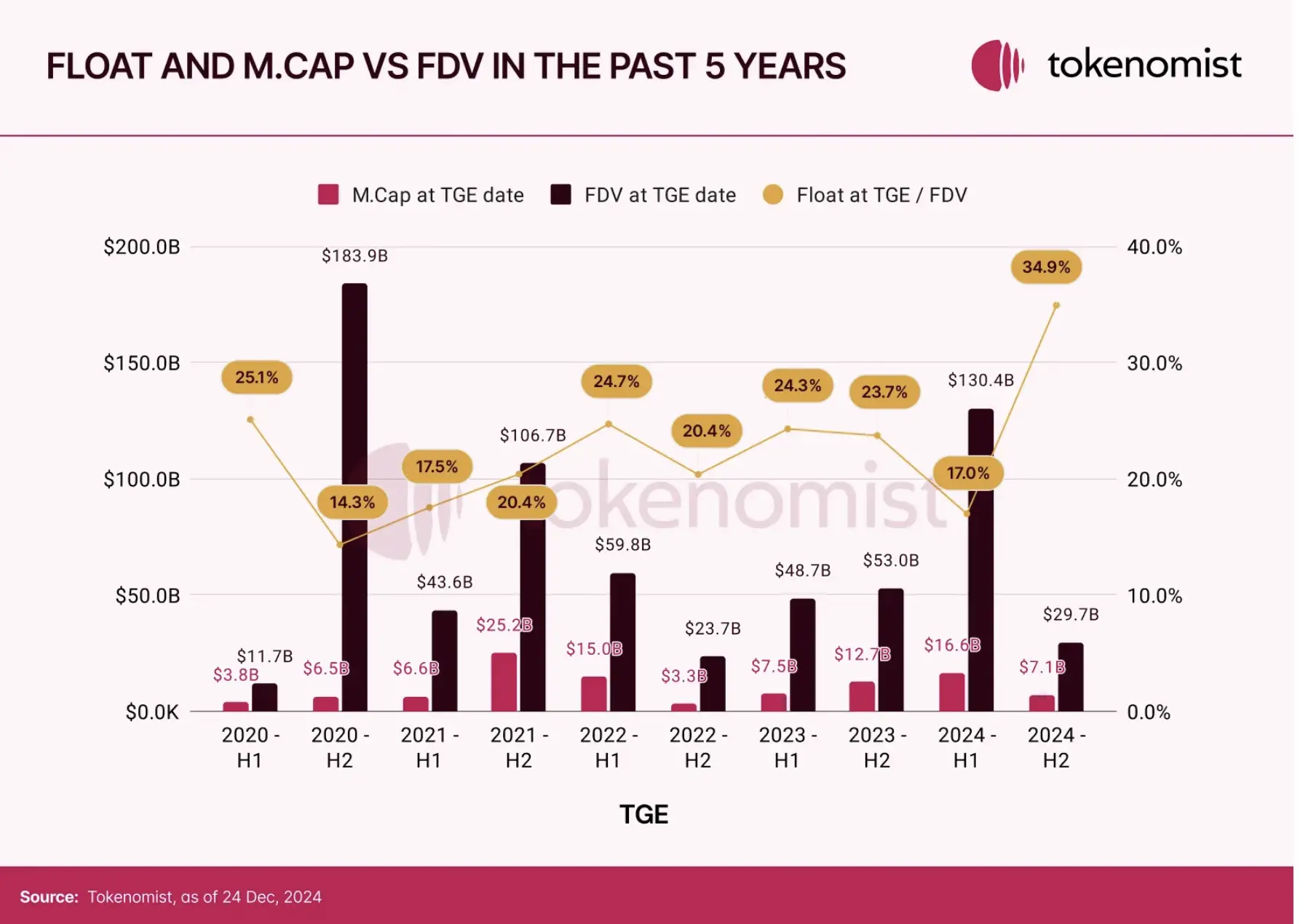
To further understand the impact of the low circulation high FDV model, we analyzed the performance of altcoins issued in 2024. We compiled key metrics, including FDV, market cap, circulation at TGE, price performance, and price changes, focusing on the top 25 altcoins ranked by FDV on the TGE date.
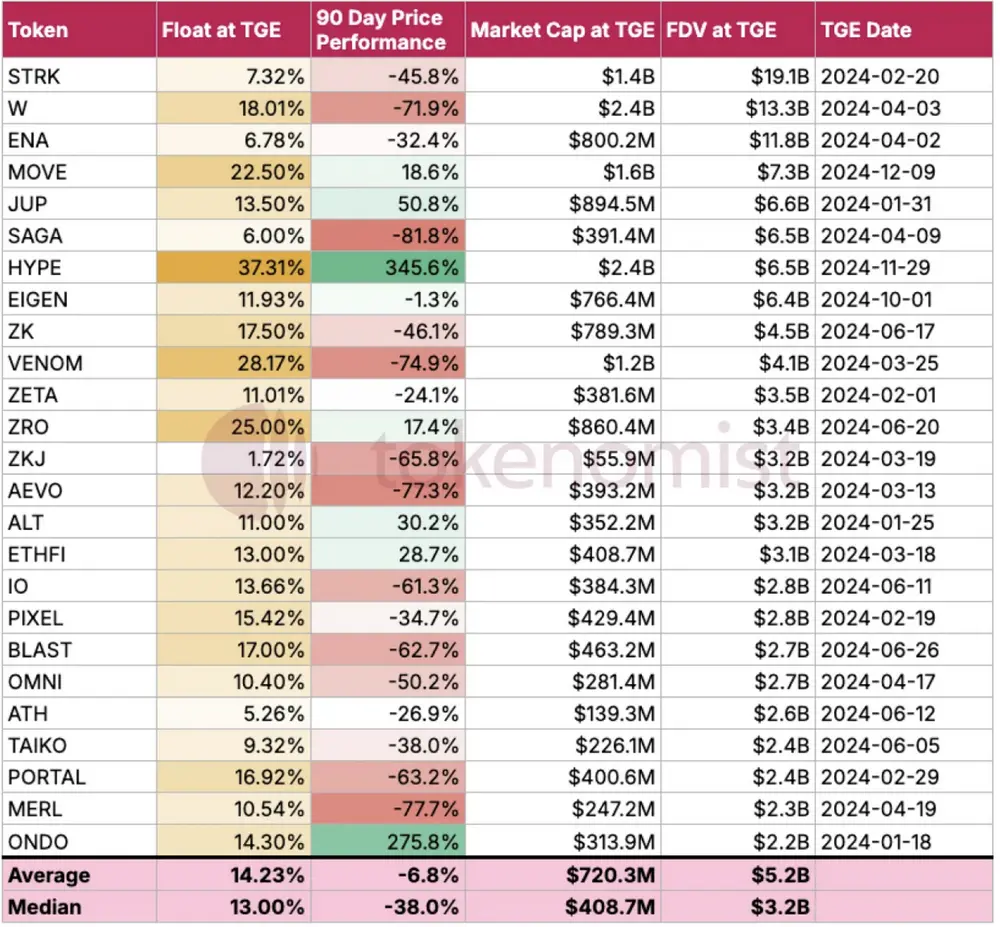
After excluding outliers like Hyperliquid and Ondo Finance, the data shows no strong correlation between circulation at TGE and this year's price performance, which can be visualized in the scatter plot below. There are many potential reasons for this. Most notably, the increase in demand and liquidity, along with greater attention to hype-driven/emotionally related narratives during the recent bull market cycle, may have reduced the correlation between circulation and price performance. On the other hand, for some tokens, the evolution of token economics has included new dimensions, such as inflationary or deflationary token economics and staking mechanisms, which may have diluted the impact of circulation at TGE.
The scatter plot of 90-day price performance against the circulation/FDV ratio at the initial pricing date. Outliers like HYPE and ONDO have been excluded.
As mentioned, there are also exceptions. Hyperliquid issued its tokens without VC unlocks, allocating 33% of its token supply to community airdrops. This approach promotes decentralization and community participation, setting a benchmark for fair token issuance.
The chart below shows the total value of token unlocks from 2020 to 2030, revealing some significant patterns from the past two bull market cycles. The total unlock value peaked at $136.7 billion in 2021, more than eight times that of 2020 ($16.9 billion). While the increase was not as dramatic, the total unlock value in 2024 ($82 billion) is approximately double that of the previous year ($47 billion). This peak aligns with the highs of the previous bull market, during which many projects locked a significant amount of token allocations for future release at issuance.
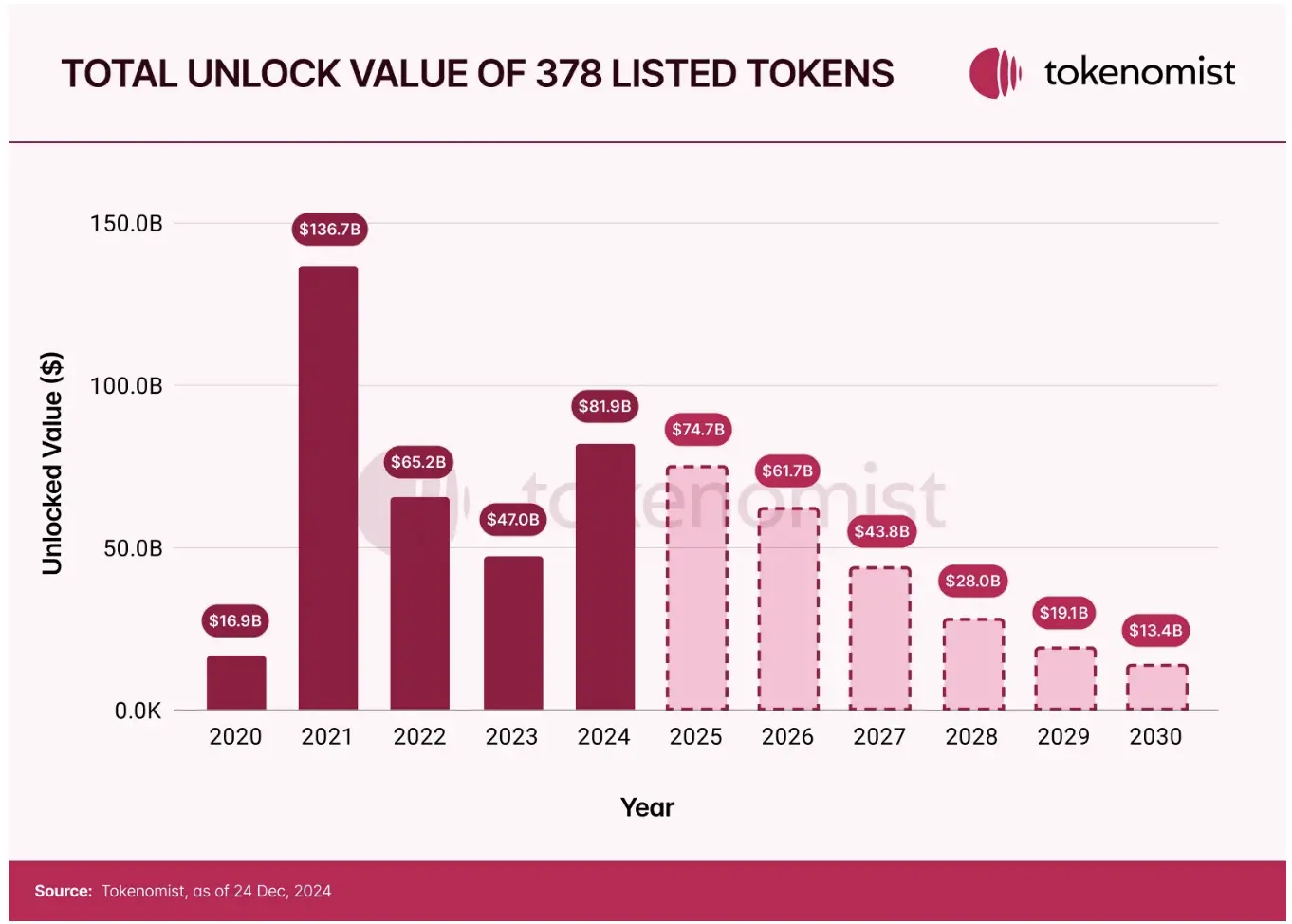
Looking ahead, the market will face significant unlock pressure. From 2024 to 2025, over $150 billion in tokens are expected to be unlocked, with approximately $82 billion absorbed in 2024 alone. This poses short-term risks to market stability. However, as lock-up plans are completed, the reduction in unlock pressure may contribute to long-term market stability.
The low circulation high FDV token model has proven to be a double-edged sword. While it can drive rapid price appreciation, it also brings significant risks due to future dilution and unsustainable valuations. As the crypto market matures, both investors and project teams must carefully evaluate token economics to ensure alignment with long-term goals. The evolution of token distribution mechanisms like Hyperliquid offers promising alternatives that emphasize fairness and sustainability.
It is important to note that these predictions are based on data from 378 tokens tracked by Tokenomist, representing a portion of the market. New token issuances and changes in existing token economics, such as re-locking or burn mechanisms, could alter these dynamics.
MEME and AI Agents
Throughout 2024, Bitcoin maintained its dominance in the cryptocurrency market, attracting an increasing number of investments from the traditional finance sector. However, sentiment regarding the poor performance of altcoins has also been growing. Despite a surge in growth at the end of the year, many altcoins failed to follow in Bitcoin's footsteps.
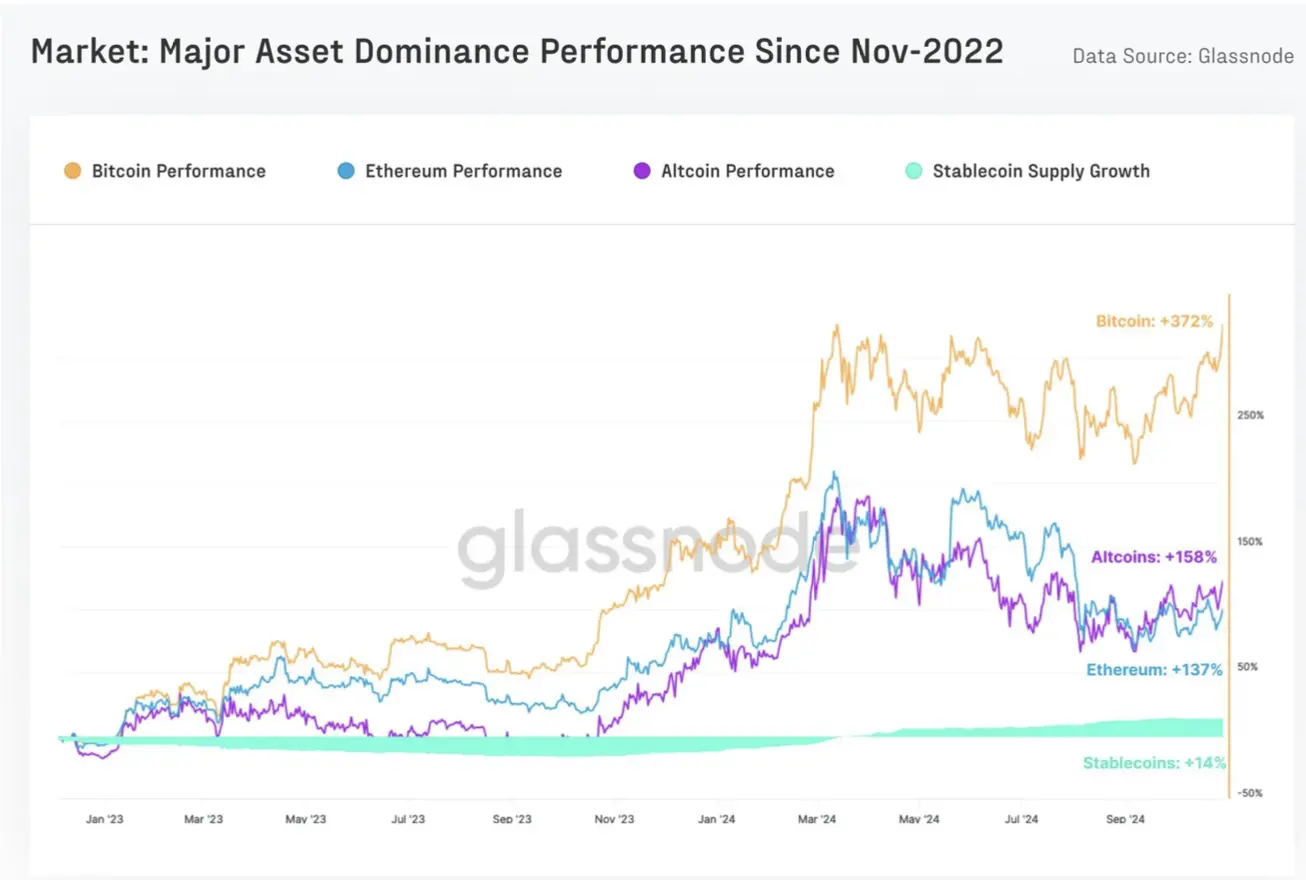
Source: Glassnode x Fasanara_Digital Assets Report Q4 2024
Analysis shows that among the top 250 altcoins by market cap, only 28.1% outperformed Bitcoin, while 45.5% outperformed Ethereum.

In contrast to the broader altcoin market, one sector significantly outperformed its peers: Memecoins. This sector demonstrated extraordinary growth in 2024, achieving a year-to-date return of 536%—a performance that surpassed Bitcoin and Ethereum by 177% and 300%, respectively. Notably, among the top 54 tokens by market cap issued this year, 19 were Memecoins.
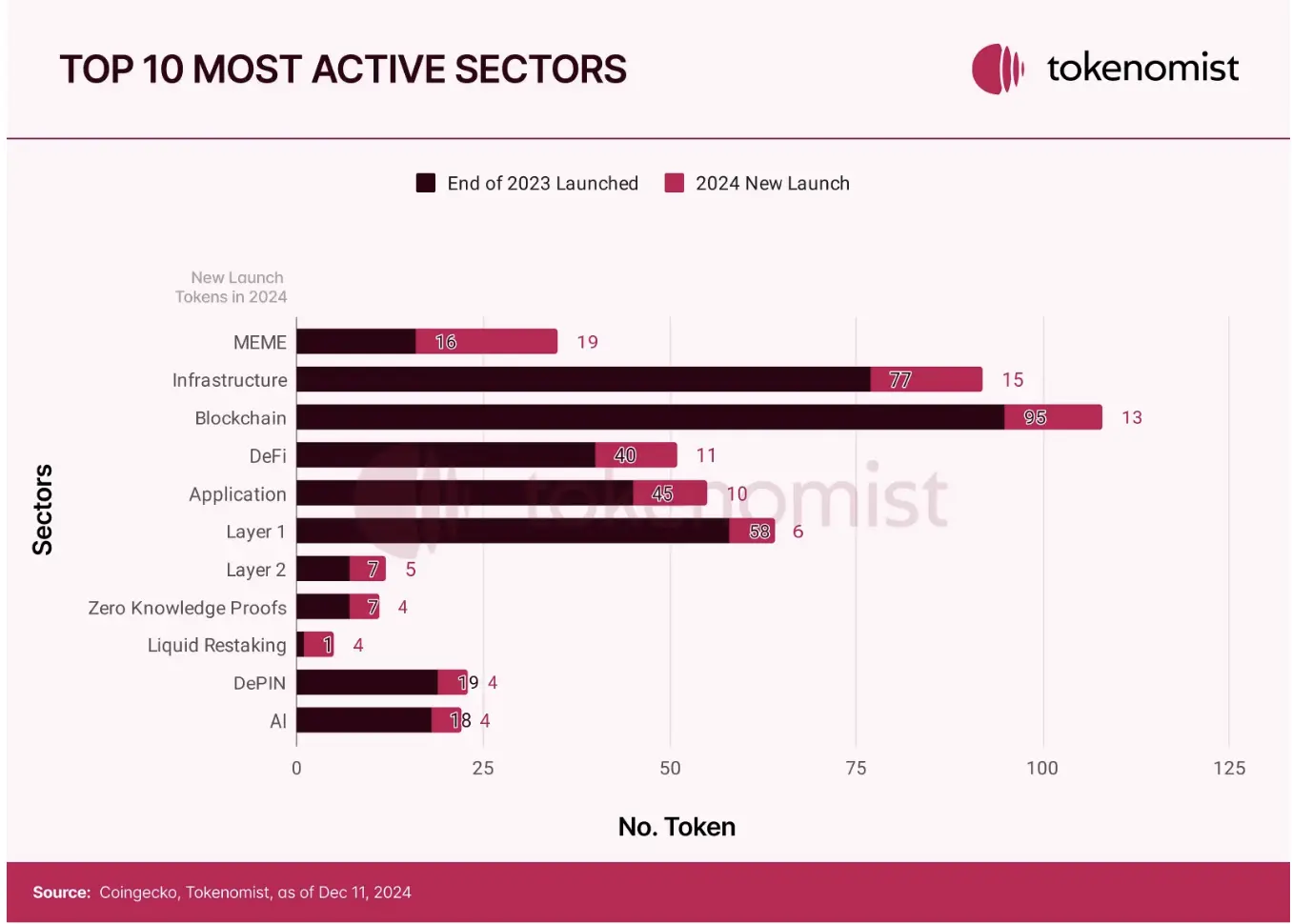
The Appeal of Memecoins
The remarkable success of Memecoins raises important questions about their appeal and the reasons for their sustained popularity. This section explores the data and motivations behind this unique phenomenon.
· Fair Distribution Model
One of the main factors driving the appeal of Memecoins is their fair distribution model, which provides the entire token supply to the community from day one. This approach ensures 100% circulation, aligning with the core principles of cryptocurrency: fairness, transparency, and decentralization. Unlike many other projects, Memecoins avoid excessive team allocations or early investor privileges, promoting equitable participation.
This fair distribution model resonates strongly with investors, especially as dissatisfaction with venture-backed projects grows. Such projects are sometimes criticized for having complex token economics and allocation structures that may appear biased toward early stakeholders.
Additionally, Memecoins offer a simpler and more understandable narrative compared to other altcoins, which often require significant technical expertise to evaluate. Memecoins focus on community engagement and cultural relevance, making them an effective tool for attracting new users to cryptocurrency.
· Long-term Community Incentive Alignment
The traditional approach to building Web3 communities primarily relies on token airdrops to incentivize early contributors. These rewards are often targeted at individuals who create content, participate in Discord, or engage in protocol-specific activities. While this model effectively sparks initial interest, our analysis reveals significant flaws in long-term community retention. Research shows that airdrop hunters often sell their tokens immediately after receiving them, especially when allocations do not meet expectations, leading to decreased community engagement and potentially negative sentiment towards the protocol.
Our study indicates that Memecoin projects have demonstrated significant success in building sustainable communities through an innovative incentive alignment approach. These projects effectively merge the interests of the team and the community, creating a situation described by market participants as "the best marketing is a price increase." Drawing on Murad's framework, successful crypto communities often exhibit characteristics similar to fervent followers, with loyal supporters and unique shared beliefs. This phenomenon generates strong collective enthusiasm among participants, enhancing retention rates and driving organic growth through community-driven initiatives. This approach creates a gamified environment where users feel directly connected to the project's success, motivating them to maintain long-term engagement.
· Community Takeover: A New Paradigm
An emerging trend in protocol governance is community takeover (CTO). When the original developers of a project abandon it, community users and token holders take over the future direction and management of the project, resulting in a community takeover. When a project shifts to community ownership, token holders become both owners and operators. This dual role fundamentally alters their relationship with the project. Community members must actively participate in governance, development, and marketing to maintain and enhance the value of their held tokens.
· Growth Catalysts
A major catalyst for the Memecoin phenomenon in 2024 is pump.fun, which aims to enable more people to easily create and trade their own tokens, significantly lowering the entry barrier. Since its launch in January 2024, over 5,581,665 tokens have been created on pump.fun as of January 6, 2025. As shown in the figure below, most Solana-based tokens are now issued through pump.fun rather than traditional methods. The success of pump.fun has also sparked competition, with other blockchain ecosystems exploring similar platforms to capitalize on the growing interest in fair token issuance.
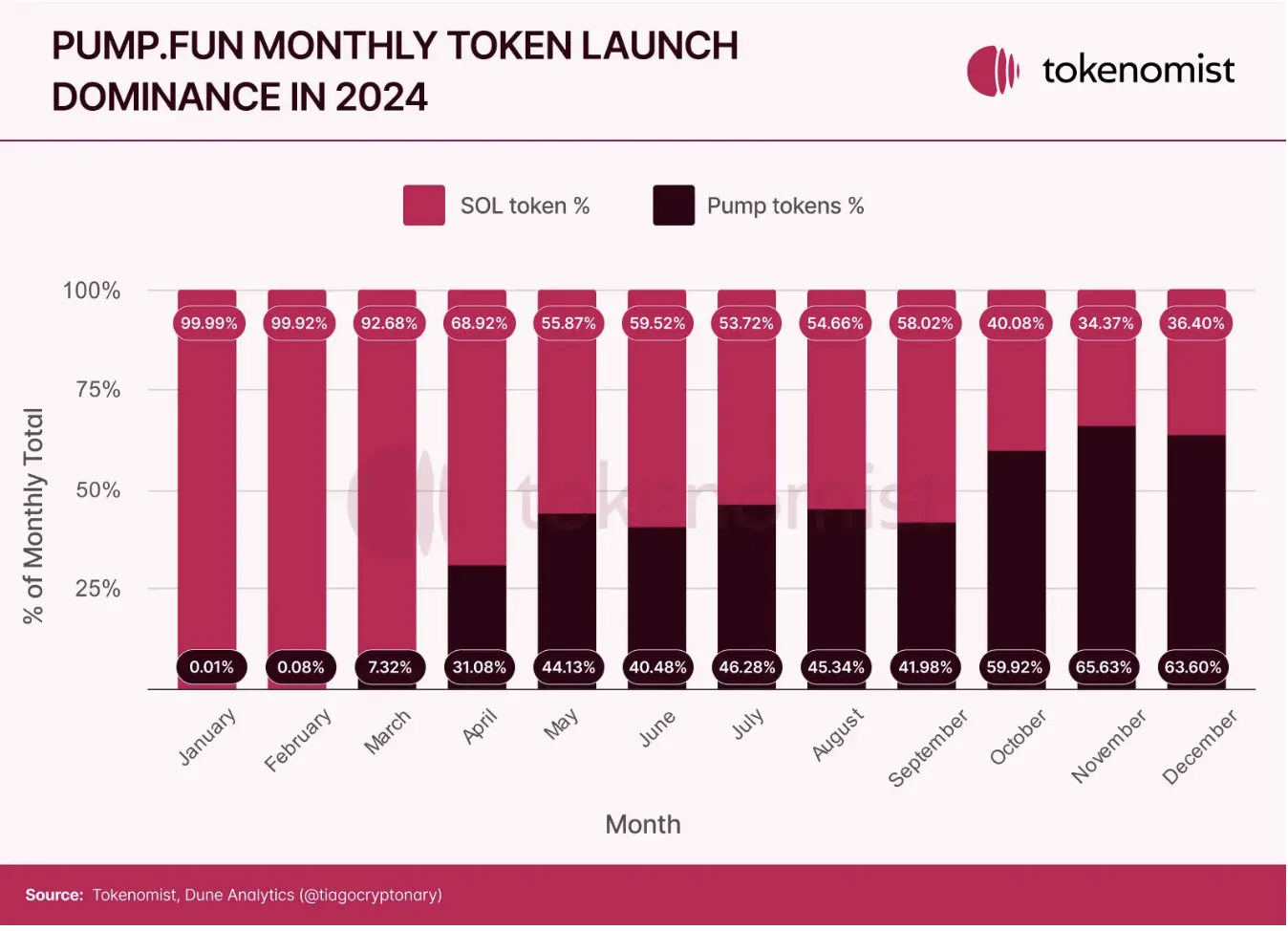
· Risks and Limitations
Despite the popularity of Memecoins in 2024, they still carry inherent risks. Like unissued tokens, Memecoins are essentially a trend, often experiencing rapid popularity followed by equally swift decline. Similarly, the oversaturation of repetitive Memecoins may dilute their impact, as illustrated by Murad's "Memecoin Pyramid," where successful Memecoins constitute a small proportion compared to those that gradually fade away.
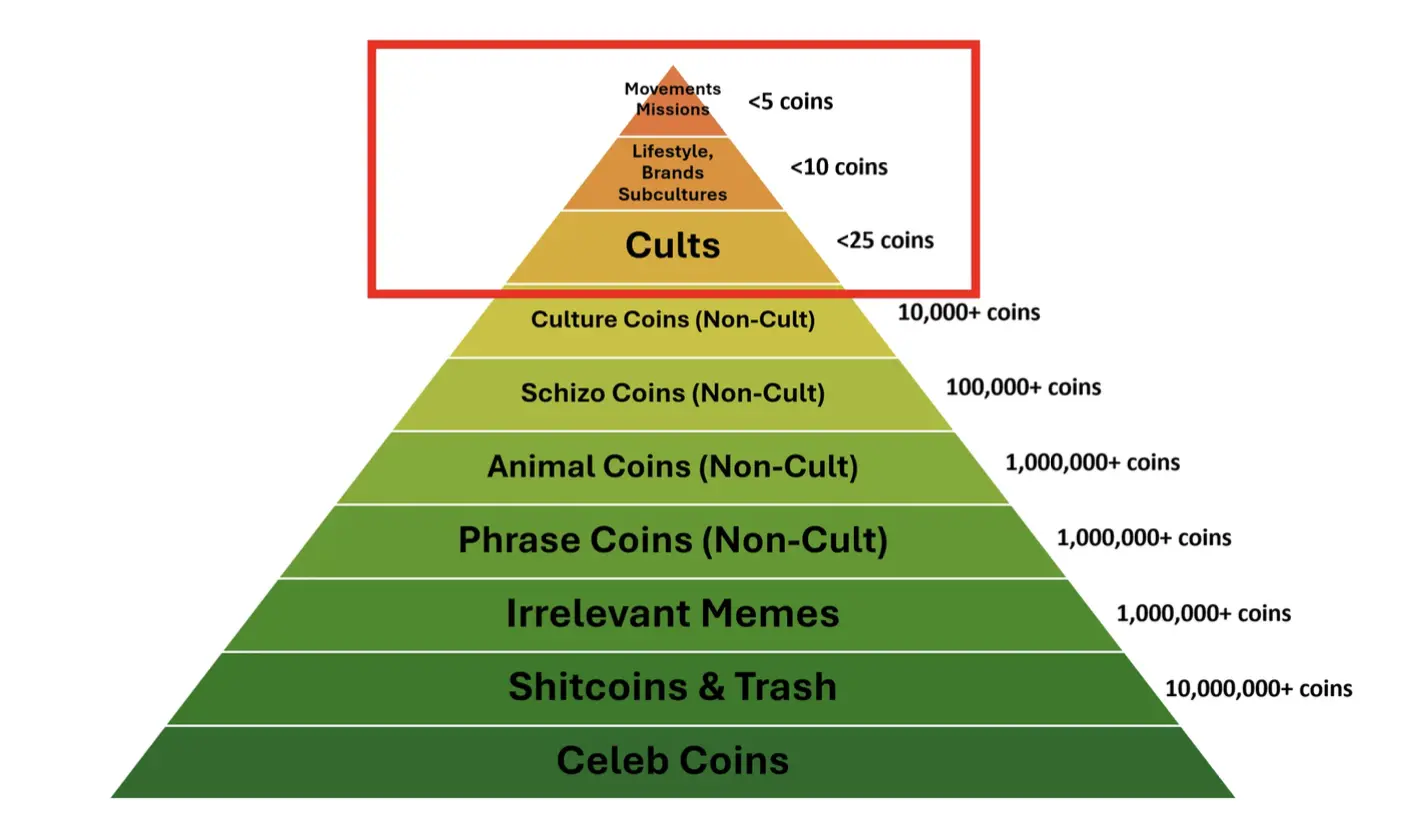
Murad's Memecoin Pyramid Source: Meme Coin Supercycle - TOKEN2049
The long-term success rate of Memecoins is significantly low. According to Chainplay's "2024 Memecoin Status" report, the average lifespan of a Memecoin is one year, with 97% ultimately deemed "dead" (defined as having a 24-hour trading volume below $1,000, liquidity below $50,000, and no updates on Twitter for three months). Currently, only one Memecoin on pump.fun has a market cap exceeding $1 billion, and eight have market caps over $100 million.
Another key risk is the potential for malicious activities. Despite being fairly issued, insiders or developers may still control the majority of tokens, undermining the principles of decentralization and allowing for pump-and-dump schemes. Although pump.fun combats this through its bonding curve mechanism and the method of "graduating" tokens to Raydium, scams may still go undetected. Even fairly issued Memecoins have seen cases where teams or insiders use virtual wallets to target meme coins. Websites like gmgn.ai are worth consulting for metrics that analyze risks, such as the top 10 token holders, blacklists, developer activity, and bubble charts.
AI Agents
Another prominent area in 2024 is AI agents. AI agents are essentially autonomous entities capable of executing tasks and interacting with other users/agents, utilizing blockchain technology for on-chain operations. They are likened to enhanced Memecoins, as they combine memes, AI, and social media elements to create autonomous entities that can interact with users and self-propagate. In 2024, we saw the emergence of major players like Virtuals and ai16z, providing frameworks for the development and deployment of AI agents.
In an article about crypto predictions for 2025, Haseeb Qureshi, managing partner at Dragonfly Capital, predicted that tokens related to AI agents would surpass Memecoins in the coming year. He believes that unlike KOLs and influencers, AI agents never rest, conform to the majority opinion, and act less out of self-interest. They also excel in aggregating and amplifying real-time information. Current agents like aixbt create alpha information streams by scraping social media data, showing potential for incremental improvements in the next year or two.
Nevertheless, Qureshi predicts that the innovativeness of these agents may wane over time. An oversaturation of AI agents could lead to a reversal in sentiment, with the crypto community potentially returning to a preference for human support. Of course, this is also a natural shift in trends. However, Qureshi suggests that the truly transformative impact in this field will come from software engineering agents, which have the potential to fundamentally change the development and security of blockchain projects.
Broader Impacts
Additionally, it is worth noting that the DeFi sector has continued to innovate over the past year. OG projects like Aave have maintained strong performance, achieving record high deposit amounts this year. Meanwhile, new projects like Ethena have also attracted increasing attention from the traditional finance sector. RWA projects like Ondo Finance have exceeded expectations this year, likely driven by the growing demand for tokenized financial products.
The success of Memecoins and their community-driven token economic model has incentivized other sectors to adopt similar fair issuance practices, such as DeSci tokens. Another clear trend is that an increasing proportion of projects are allocating larger shares to the community during token issuance.
Another potential trend to watch for is the fusion of Memecoins and utility. User @hmalivya9 on X proposed the concept of "community clusters." This model suggests collaborating Memecoin projects with utility token projects through a staking system, allowing Memecoin holders to stake their tokens to earn rewards from multiple utility token projects. The system would enhance its effects by requiring active social media participation, essentially gamifying brand awareness for utility tokens. hmalivya9 envisions this symbiotic relationship as a blueprint for the future structure of crypto communities, intertwining entertainment and utility, a concept that is not entirely new. For instance, in Hyperliquid, holders of its native spot token $PURR can receive airdrops of other spot tokens within the Hyperliquid ecosystem and earn Hyperliquid points. $PURR can only be traded within Hyperliquid, significantly expanding its user base.
In the coming year, AI agents will also continue to develop. ai16z has proposed a token economic model where token staking serves as a verification system, providing platform access, enabling governance participation, and establishing accountability through potential penalty conditions. In this evolved staking model, stakeholders' economic interests are directly tied to their contributions to the quality and growth of the ecosystem.
2025 is sure to be an exciting year, whether through the evolution of existing trends or the emergence of new ones.
免责声明:本文章仅代表作者个人观点,不代表本平台的立场和观点。本文章仅供信息分享,不构成对任何人的任何投资建议。用户与作者之间的任何争议,与本平台无关。如网页中刊载的文章或图片涉及侵权,请提供相关的权利证明和身份证明发送邮件到support@aicoin.com,本平台相关工作人员将会进行核查。




